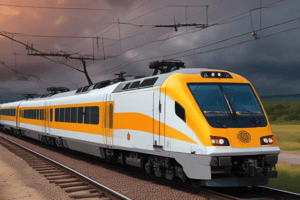Podcast
Questions and Answers
What is the primary role of the Emergency Intervention Unit (EIU) in relation to RIO/MOM?
What is the primary role of the Emergency Intervention Unit (EIU) in relation to RIO/MOM?
What should be done if there is uncertainty about the tram pantograph status?
What should be done if there is uncertainty about the tram pantograph status?
In cases of a tram incident, who acts as the incident officer until senior staff arrive?
In cases of a tram incident, who acts as the incident officer until senior staff arrive?
What is crucial to remember about patient assessment during a tram incident?
What is crucial to remember about patient assessment during a tram incident?
Signup and view all the answers
What important aspect must be ensured when communicating with individuals on scene?
What important aspect must be ensured when communicating with individuals on scene?
Signup and view all the answers
What type of railway is fully automated and driverless?
What type of railway is fully automated and driverless?
Signup and view all the answers
Where is the Croydon Tramlink primarily based?
Where is the Croydon Tramlink primarily based?
Signup and view all the answers
Which transport system has a Passenger Service Assistant on board each train?
Which transport system has a Passenger Service Assistant on board each train?
Signup and view all the answers
Which of the following train services is included in Network Rail?
Which of the following train services is included in Network Rail?
Signup and view all the answers
What priority does the Croydon Tramlink have on the road?
What priority does the Croydon Tramlink have on the road?
Signup and view all the answers
How long is the Elizabeth Line expected to stretch?
How long is the Elizabeth Line expected to stretch?
Signup and view all the answers
What is the primary purpose of the London Ambulance Service NHS Trust in relation to public transport?
What is the primary purpose of the London Ambulance Service NHS Trust in relation to public transport?
Signup and view all the answers
When will Network Rail take responsibility for the Elizabeth Line?
When will Network Rail take responsibility for the Elizabeth Line?
Signup and view all the answers
Which of the following conditions is considered incompatible with life?
Which of the following conditions is considered incompatible with life?
Signup and view all the answers
What type of injuries necessitate rapid removal to a Major Trauma Center (MTC)?
What type of injuries necessitate rapid removal to a Major Trauma Center (MTC)?
Signup and view all the answers
What is a required practice when entering and leaving trackside according to protocols?
What is a required practice when entering and leaving trackside according to protocols?
Signup and view all the answers
Which of the following must be worn in all situations according to London Ambulance Service protocols?
Which of the following must be worn in all situations according to London Ambulance Service protocols?
Signup and view all the answers
What should be done with a viable patient located in an unsafe area?
What should be done with a viable patient located in an unsafe area?
Signup and view all the answers
What is the maximum number of stations expected to be stopped at, as part of the new upgrades?
What is the maximum number of stations expected to be stopped at, as part of the new upgrades?
Signup and view all the answers
What is defined as part of the track environment?
What is defined as part of the track environment?
Signup and view all the answers
Which of the following is NOT a hazard when accessing the track?
Which of the following is NOT a hazard when accessing the track?
Signup and view all the answers
What must always be secured if working nearby?
What must always be secured if working nearby?
Signup and view all the answers
What should be done first in the case of a Person Under Train (PUT) incident?
What should be done first in the case of a Person Under Train (PUT) incident?
Signup and view all the answers
Which procedure requires face-to-face confirmation in case of an emergency?
Which procedure requires face-to-face confirmation in case of an emergency?
Signup and view all the answers
Which group is responsible for the Network Incident Response Team (NIRT)?
Which group is responsible for the Network Incident Response Team (NIRT)?
Signup and view all the answers
What should NOT be done when walking near point mechanisms?
What should NOT be done when walking near point mechanisms?
Signup and view all the answers
What is the primary function of the Pan London Emergency Response Unit?
What is the primary function of the Pan London Emergency Response Unit?
Signup and view all the answers
What is the role of the Docklands Light Railway (DLR) in an emergency response?
What is the role of the Docklands Light Railway (DLR) in an emergency response?
Signup and view all the answers
Which statement is true regarding the procedures of Network Rail?
Which statement is true regarding the procedures of Network Rail?
Signup and view all the answers
What safety precaution must be taken when dealing with the pantograph?
What safety precaution must be taken when dealing with the pantograph?
Signup and view all the answers
What is the significance of the 'Red Bond' in electrical safety?
What is the significance of the 'Red Bond' in electrical safety?
Signup and view all the answers
During an emergency response, how is the power usually confirmed off at the ground level?
During an emergency response, how is the power usually confirmed off at the ground level?
Signup and view all the answers
What action should be taken regarding unused energy from the Red Bond?
What action should be taken regarding unused energy from the Red Bond?
Signup and view all the answers
What is NOT a standard procedure for the Emergency Response Unit?
What is NOT a standard procedure for the Emergency Response Unit?
Signup and view all the answers
Study Notes
Emergency Response Units
- Pan London Emergency Response Unit equipped to handle train incidents, including jacking up, moving, righting, and cutting trains.
- Consists of 2 blue light and 2 normal units.
Docklands Light Railway (DLR)
- Confirm power off and that trains are stopped, typically verified through the Emergency Operations Centre (EOC).
- Utilize visual confirmation of short circuit device at front of train.
Network Rail Protocols
- Ensure power is off if at ground level and verify trains are stopped.
- Overhead power generally remains on; operators should lower the train pantograph.
- Communication protocols involve face-to-face or via EOC if a Network Rail representative is present; short circuit devices are not routinely used.
Pantograph Safety
- Driver should lower the pantograph to maintain safety.
- Maintain a safe distance from the orange line (safety line) atop trains, designated as 3 meters.
Red Bond Precautions
- Red bond wires are considered live; avoid any contact, especially if damaged.
- These wires can return unused energy back to the network.
Underground Railway Operations
- Automated driverless railway primarily located in East and South East London.
- Low incident frequency, with most stations unstaffed, reliant on Passenger Service Assistants onboard.
Croydon Tramlink
- Extends from Croydon to Beckenham and Wimbledon, operated by drivers.
- Has road priority, even under emergency conditions.
Network Rail Overview
- Encompasses several train companies including Virgin, Thameslink, Southern, and Eurostar.
- Will include responsibility for the new Elizabeth Line upon completion.
Elizabeth Line Details
- A new rail line spanning over 60 miles, connecting Reading and Heathrow to central London and on to Shenfield and Abbey Wood.
- Features 41 accessible stations, with an expected annual ridership of around 200 million.
Track Environment Safety
- Anything within 2 meters of the rail tracks is considered part of the track area.
- Accessing the track requires accompaniment by railway staff to mitigate hazards.
Track Safety Hazards
- Unique hazards include slips, trips, and falls; cables and equipment may pose risks.
- Points may shift unexpectedly and must be secured when working nearby.
Person Under Train (PUT) Incident Procedures
- Power-off and train stoppage confirmation are critical before intervention.
- Require protocols such as PORES (Power Off Request – Emergency Services).
Emergency Services Coordination
- Ensure proper communication with authorized personnel on scene during emergencies.
- Follow ROLE (Rapid On Scene Assessment) protocol to determine viability of patients.
Personal Protective Equipment (PPE)
- Strict adherence to wearing PPE is mandatory for all responders entering track areas.
Scene Management
- Notify EOC and scene commander upon entering or leaving trackside.
- Maintain consistent communication on the LAS talkgroup during underground operations.
Major Trauma Patient Management
- Rapid removal of trauma patients to major trauma centers (MTC) is critical for surgical intervention.
Studying That Suits You
Use AI to generate personalized quizzes and flashcards to suit your learning preferences.
Related Documents
Description
This quiz explores the emergency response protocols utilized by the London Emergency Response Unit, particularly focusing on their capabilities in handling train incidents. It examines the role of the London Ambulance Service and the Docklands Light Railway in managing emergencies across the transport network.




